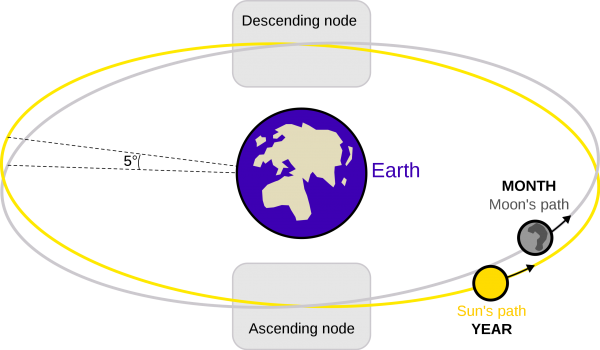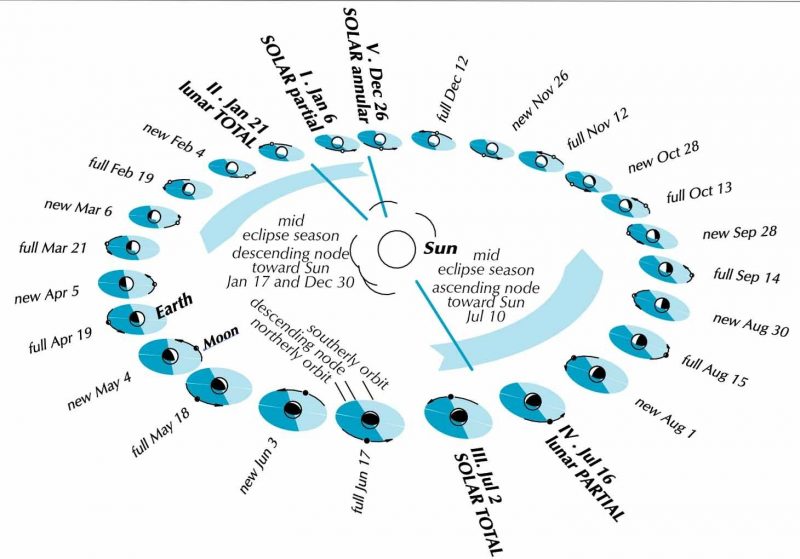On May 9, 2019, the waxing crescent moon lodges in front of the constellation Gemini the Twins, shining to the south of the Gemini stars, Castor and Pollux. The bright star on the other side of the moon is Procyon, the brightest star in the constellation Canis Minor the Little Dog. Every month, as the moon makes its monthly rounds in front of the constellations of the zodiac, the moon always passes to the north of Procyon and to the south of the Gemini stars, Castor and Pollux.
On this date – May 9, 2019 – the waxing crescent moon aligns with the ecliptic – Earth’s orbital plane projected onto the great dome of the sky. The green lines on the sky charts above and below depict the ecliptic. Before May 9, 2019, the younger waxing crescent moon was to the south of the ecliptic, as shown on the sky chart below.

Want to understand something about how eclipses happen? Earth’s orbit around the sun creates a flat plane that astronomers call the ecliptic. The moon’s orbit around Earth is a second flat plane, inclined to the Earth-sun plane by about five degrees. The moon in its orbit intersects the plane of Earth’s orbit at two points called nodes. The moon crosses these nodes every month – ascending from south to north, and then some two weeks later, descending from north to south. Astronomers call these crossing points ascending and descending nodes.
Eclipses of the sun or moon can happen only when the new moon or full moon is near a node. That’s the only time that we on Earth see the new moon pass directly in front of the sun (solar eclipse), or see the Earth’s shadow fall on the full moon (lunar eclipse).
On May 9, 2019, the waxing crescent moon crosses the ecliptic (plane of Earth’s orbit around the sun) in front of the constellation Gemini the Twins. Because the moon is crossing the ecliptic from south to north, the moon is said to be at its ascending node.
Eclipse this month? No, because the moon has to be either at the new phase (closest to being between the Earth and sun for that month) or full phase in order for an eclipse to take place. But we’re headed toward a total solar eclipse in early July 2019, visible from South America. Keep reading …

Every month this year, in 2019, the moon crosses the ecliptic at its ascending node in front of the stars of Gemini.
What’s more, the moon will continue to cross its ascending node in front of the constellation Gemini until March 2020. By April 2020, the moon’s ascending node will finally move over into the constellation Taurus the Bull, the constellation to the immediate west of Gemini.

Next month, when the moon crosses its ascending node on June 5, 2019, the moon will exhibit a thinner waxing crescent phase in front of Gemini.
In July 2019, the new moon will take place in front of the constellation Gemini. Moreover, it’ll take place less than 1/2 day (12 hours) before the moon reaches its ascending node. The close coincidence of new moon and ascending node means a total eclipse of the sun along a narrow corridor of the Earth’s surface on July 2, 2019.
New Moon: July 2 at 19:16 UTC
Ascending node: July 3 at 6:53 UTC
This month, the new moon – or moon closest to being between the Earth and sun for this month – occurred on May 4, 2019, to the south of the ecliptic in the constellation Aries the Ram. Next month, the new moon on June 3, 2019, will take place to the south of the ecliptic in the constellation Taurus the Bull.
Then, at long last, the new moon and a solar eclipse will happen in front of the constellation Gemini the Twins in early July 2019.
Read more: South American solar eclipse on July 2
Bottom line: Tonight – May 9, 2019 – let the waxing crescent moon introduce you to the constellation Gemini the Twins, the constellation that’ll host the solar eclipse of July 2, 2019, and the penumbral lunar eclipse of January 10, 2020.

Resources:











